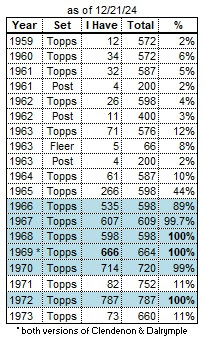As Ed McMahon always said to Carnac, “I hold in my hand the last…”
There were 490 players with their own card in the 1967 Topps set. Before today, I had blogged about 489 of them on one or another of my set blogs. And now, last but (not?) least…
Monteagudo was signed by the Kansas City Athletics in 1961, and played in the minor leagues every season from 1961 to 1973. After playing in the Mexican League from 1974-1980, he made a 1-game comeback in 1983 with the Angels’ AAA team.
Aurelio made his major-league debut in September 1963 with the Athletics, appearing in 4 games in relief. In 1964 he pitched in 11 games, starting half of them. Those would be his last major-league starts except for his one game with the White Sox in 1967.
After 4 relief appearances in 1966, the A’s sent him to the Astros in May, where he made 10 relief appearances.
At the end of the 1966 season, the Astros sold him to the Reds, but he never played for the Reds in the majors or minors, and was released in mid-July.
On the same day, the White Sox signed him, and after starting one game, he was cut a week later. On THAT same day, the Reds picked him up. (Essentially, he was loaned out to the White Sox for one game.)
Monteagudo did not play for the remainder of 1967, but pitched for the Reds' farm teams for all of 1968 and the first half of 1969.
In June 1969 he was traded to the Cardinals for pitcher Dennis Ribant. Playing no games for St. Louis, he was selected by the Royals in the post-1969 minor-league draft. He started the ’70 season in the minors, but pitched 21 games for the Royals in the second half, before returning to the minors for all of 1971. (Wow, Topps had their hands full dealing with his yo-yoing career!)
In November 1971 he was selected by the Brewers in the Rule 5 draft. (Ok, that explains his 1972 card with the Brewers.) However, he was released during spring training, having never played for Milwaukee. The same day, the Padres took THEIR turn on this merry-go-round, but by mid-June they swapped him to the Angels for infielder Ron Clark.
Aurelio pitched 15 games for the Angels in the second half, then was dealt to the Phillies in December. Monteagudo never played for the Phillies, but did show up as a Phillie in the 1974 “Traded” subset. (If you couldn’t make the 1974 Phillies’ bullpen, you know it’s time to hang them up.)
That’s exactly what he did, moving down to Mexico where he was primarily a starter for 4 different teams from 1974-80.
So, I have posted all the 1967 player cards I planned to, but that's not the end of this blog. I still need to complete my team reviews for the Astros and the Mets, then just freelance whatever comes along.












.jpg)
.jpg)
.jpg)
.jpg)
.jpg)
.jpg)




.jpg)
.jpg)
.jpg)
.jpg)



.jpg)



.jpg)










